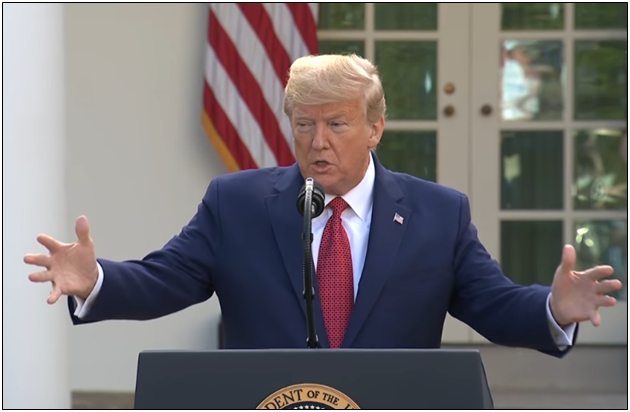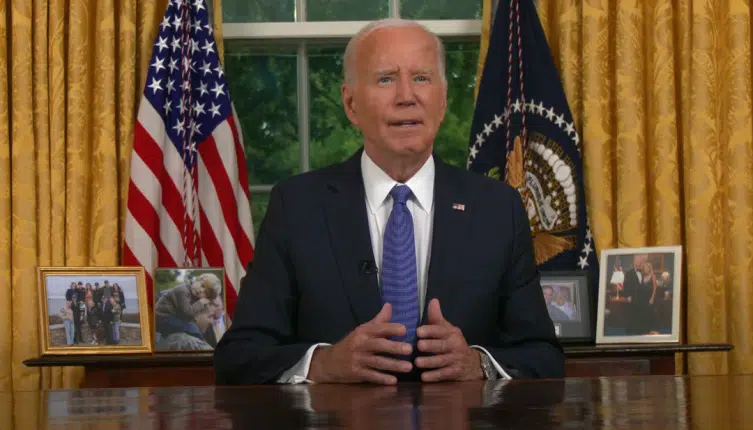President Donald Trump has extended the federal government’s recommendations to engage in social distancing, keep schools closed and to work from home if you can a few additional weeks until May 1 as nationwide efforts continue to combat the Chinese coronavirus and to save as many lives as possible.
Initially, President Trump had stated April 12 as a national goal for potentially reopening the country, but now says that he is pushing that off three weeks as the White House coronavirus task force expects the virus to be peaking at that time.
On March 29, Trump explained the change, saying, “It [April 12] was just an aspiration… Sadly to say, that could be the peak number of deaths before it starts coming down…”
Trump does not want to reopen everything prematurely and then the numbers start going up again: “[W]hen you hear these kind of numbers and you hear the potential travesty, we don’t want to do anything where — you know, we don’t want to have a spike up. We don’t want to do it soon, and then all of a sudden you go down — you’re coming down and then you start going up again. Because we discussed that can happen, and we don’t want that to happen. We’ve gone through too much.”
So, the nation will remain on a war footing against the virus for at least another month as state governors step up stay at home orders in as many as 29 states as of this writing. Schools in every state are closed.
The President has signed into law a $2.2 trillion package to support the U.S. economy, save millions of small and large businesses and tens of millions more jobs, by helping entities to meet payroll during the national lockdown.
The Army Corps of Engineers and the Federal Emergency Management Agency (FEMA) has built upwards of 2,900 hospital beds at the Javits Center in New York City, with additional efforts in Louisiana and New Jersey, the President reports. The USS Comfort has arrived in New York Harbor.
The Food and Drug Administration (FDA) has expedited approval for testing and for various antiviral treatments for the virus. When this is over, this process could be reexamined to help bring life-saving treatments for other conditions to patients faster, too.
The President has invoked the Defense Production Act to expedite the manufacture of critically needed patient ventilators and protective gear for medical professionals.
And, thanks to the private sector getting involved, more than 1 million tests have been administered in the U.S., far more than any other country. So far, 140,000 cases have been identified as of this writing, and more than 2,400 Americans have died.
But we probably need a lot more testing so that we can defeat the virus and get back to work as soon as possible.
Last week, Dr. Deborah Birx, the task force’s coordinator, questioned whether we were testing the tip of the iceberg or just not understanding transmission based on what we’ve been seeing on the ground. That was in the context of an antibody test being developed. This is the type of test done with the blood that will tell a patient if they have or have had the virus, called serological testing.
With randomization and a large enough sample, health professionals should be able to produce more accurate data about the rate of infection and mortality, which can then be used to inform public policy decisions. Ideally, you’d like that information before you initiate closures but this came on so fast that all countries had time to do so far is test people with symptoms.
If conducted across the population of a state or several states, such testing could give the President and state governors the information they will ultimately need to begin reopening things. State governors will likely continue to air on the side of caution and remain closed so long as the infection and true fatality rates remain unknown.
At the end of the day, we need more complete data on how many people are getting the virus in total and what the real mortality rate really was as a useful check on the future exercise of the government’s powers in this case to close almost the entire economy. The initial data from South Korea indicated the virus was about 8 to 10 times worse than the seasonal flu in all age categories, similarly impacting seniors the most.
But that was with symptomatic testing. What about asymptomatic testing? How do we know what percent of the population is really infected and spreading the virus asymptomatically? And how do we know what the real mortality rates are? Reported fatalities in China and Italy are much higher than South Korea, Germany and the U.S.
On March 27, the President hinted that more widespread testing could be on the way, saying, “Widespread surveillance testing will allow us to monitor the spread of the virus… This surveillance testing will soon enable us to publish updated guidelines for state and local leaders. We want every county and region in the country to have the on-the-ground evidence that they need to determine the mitigation measures that are right for them… And we’ll be able to have very accurate information very shortly. We already have a lot of that information.”
Dr. Birx on Friday added, “what we’re going to work on over the weekend is to weave together both a testing strategy for surveillance… while maintaining a strong testing for diagnosis.”
Since this is going to cost $2 trillion or more, I think the American people have a right to know what the true risk really was.
Without mitigation, the task force says the high end of deaths could be 2.2 million.
Even with mitigation, the President team reports anywhere from 80,000 to 160,000 deaths from the virus in the U.S. is possible. Dr. Birx further emphasized this point on March 30 on NBC, stating, “We’ve looked at the Italy data with their self-isolation, and that’s where we come up with if we do things together well, almost perfectly, we could get in the range of 100,000 to 200,000 fatalities. We don’t even want to see that.”
But are we sure? A randomized study would test the assumptions being made by public officials today and the models advising those decisions, and we’d be able to go back and say if these actions are overkill, or if they potentially really are saving perhaps 2 million lives here, more than we’ve lost in every war we ever fought put together.
So, even if one believes efforts being undertaken are too costly, and that the threat of the virus has been overstated, that would still make the case for this sort of testing to be done. If so, then the test will prove it. Or if one thinks that these types of measures are necessary to save lives now and in the future, that would also make the case for that type of testing as soon as possible to validate the approach that’s been taken.
Either way, it’s a way of checking everyone’s work and being able to make adjustments going forward. We’d all like to see the country reopen as soon as possible, but that might not happen until the President and state governors have data they can lean on that says it’s safe to do so.
Robert Romano is the Vice President of Public Policy at Americans for Limited Government.







